At dawn on the 16th, Black-capped Chickadees are singing ‘fee-bee’ through a gray 13 degrees along the tracks. Common Ravens, tough as always, gamboling, croaking, unheeding of the bitter cold. Rock Pigeons up in swirling flocks about town—I swear they get more active the colder it gets. Don’t they feel a need to preserve energy?
American Goldfinches, buzzing and whistling, are all over the black birch catkins on the steep of Sapsucker Ridge just above the rails. One hundred, at least, zip back and forth in front of me to trees along the river, an all-time high for Plummer’s Hollow. I scan the crowds for rarer finches, but find only black streaks and mustard-y hues. I’m pleased with myself for correctly predicting a banner goldfinch season; numbers tracked very high this year compared to previous years, and it looks a lot have stayed around.
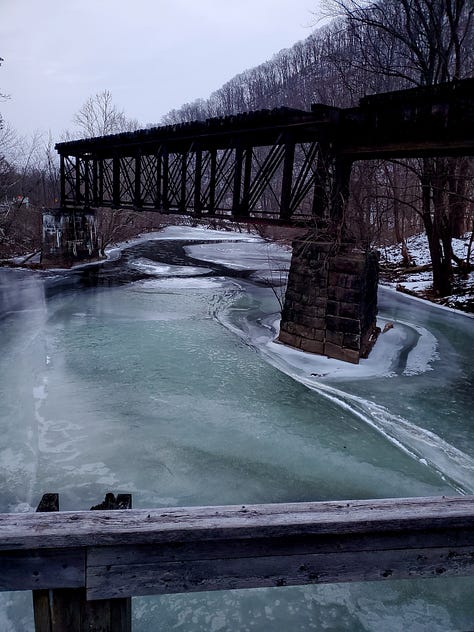
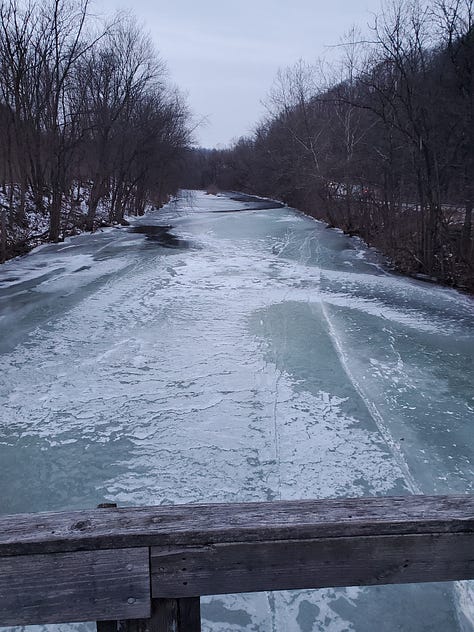
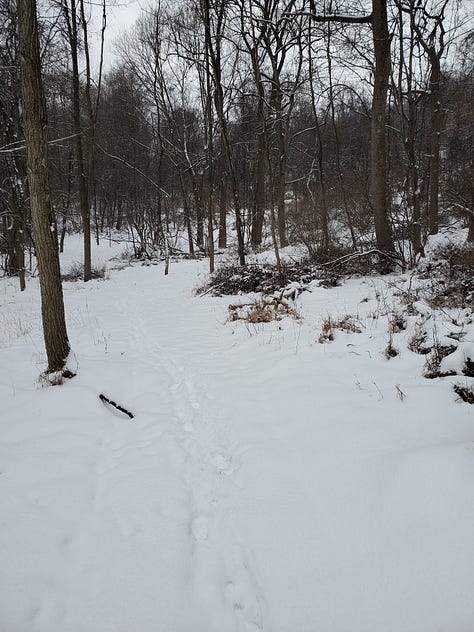
Owling
The owls have been dismal so far this year, but so has my effort. I’m out before 6 AM on the 17th, putting the lock back on gate, when owl # 1 sounds off; a loud, wavering Eastern Screech-Owl not far away upslope. An uncountable number of Canada Geese honk above me. I trudge up the dark hollow through the fresh snow with the temperature a balmy 31 degrees, trying all the common calls, but nothing. Much farther up, another screech-owl calls, and then, for the first time ever in the depths of winter, the unmistakable toots of a Northern Saw-whet Owl off on Laurel Ridge somewhere. With winter getting set to deepen, this tiny, close-to-invisible denizen is already talking about breeding.
/ The next afternoon, Dave hears the first Barred Owl of the year, and not long after that, Eric’s PUC microphone picks up a Great Horned Owl. /
This morning’s trek first involves a Sinking Valley scan from the powerline, first of the year. I pull out all the gear and glass the fields for larks and harriers, but the best I can dig up are the calls of a FOY Northern Mockingbird. Later, I circle back around the houses and then down into the bird havens of Sapsucker Ridge, where a dwindling number of White-throated Sparrows are kicking up their usual ruckus. An Eastern Towhee reeps from somewhere off in the snow-covered vine tangles. Snow-hee?
Above the bridge over the Little Juniata, a Hermit Thrush is pecking about the snow in the narrow space between the busy highway and the growing ice shelf.
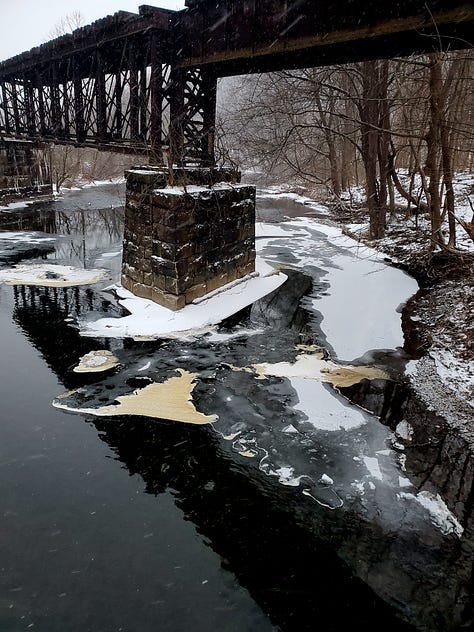
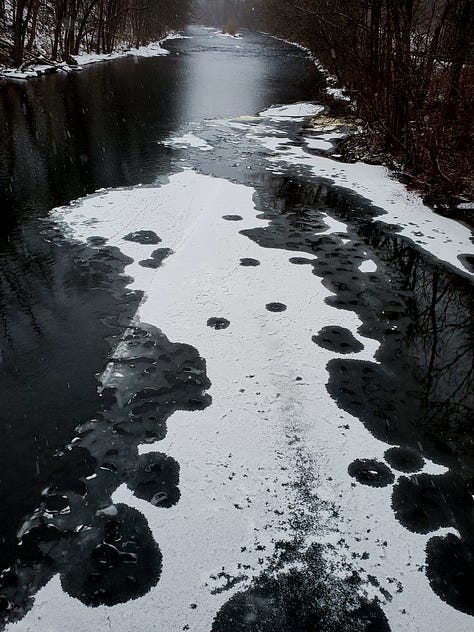
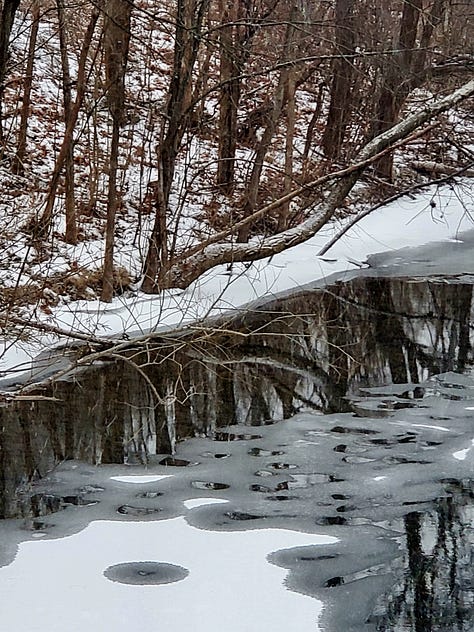
Cusp
The 19th: a quiet Sunday trek along the tracks, looking ahead to a week that promises multiple sub-zero mornings. With nothing new in the area birdwise, the main interest now is observing unusual behaviors and unusual places as birds run out of preferred food supplies. Goldfinches don’t disappoint—the catkin flock is now at least 168 individuals, loosely grouped in 20s and 30s, streaming down the ridge and over the tracks. They don’t seem spooked by me, but trains send them whirling away in clouds.
One thing I’ve noticed this January - the local Pileated Woodpeckers who roost high up on the ridges are quite vocal and active. The other day I saw them along the river, below the bridge, and now, almost every time I’m out here, they swoop across the Gap between the two mountains, cackling with wild abandon. Hairies have also become more conspicuous than Downies, and at least one Red-bellied hangs about as well—a species I rarely see along the river.
Otherwise, there’s little out of the ordinary, with the typical handful of Golden-crowned Kinglets and Brown Creepers, a Winter Wren, and the more common species.
The river has unfrozen just a bit with slightly warmer temperatures, but there are no waterfowl around this morning.

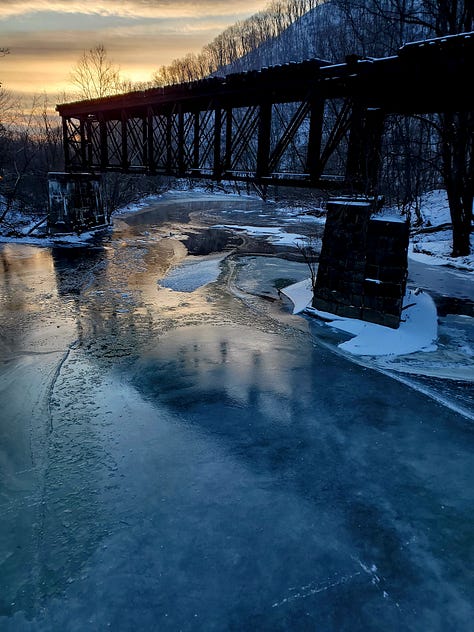
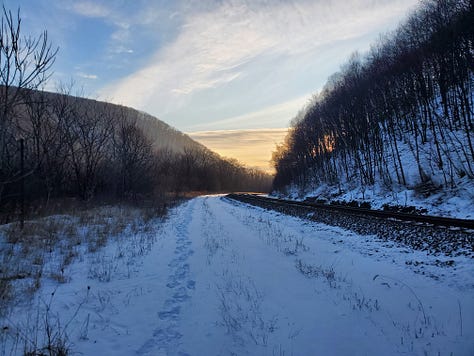
Deep Freeze
As promised, Siberia shows up, appropriately, on Tuesday the 21st. The temperature in Tyrone is already below freezing by 4 AM, and heading lower. At -7 degrees, not long before 7 AM, I suit up and head out on foot. The air is dead calm, but I can feel the stickiness in my nostrils. Nothing is stirring, and after days below freezing, the streets are still slick with packed snow, the sidewalks blooming with salt roses. I check the Amundsen-Scott South Pole Station: -4.
The river froze nearly solid in the night, with only a few remaining open patches in the riffles. Despite the cold, the birds wake up on their regular schedules, with white-throats, Dark-eyed Juncos, and Northern Cardinals the first to stir from the private jungle. Nothing moves in the air: I wonder if it’s too cold for comfortable flight? The sky is empty all the way down to the buried pond, but as I’m turning around for the slog back, weighed down by heavy Baffin boots, nine American Robins drift over, calling, from the east side of Laurel Ridge toward a feeding spot out in the valley somewhere.
The spell is broken. At 8 AM, as the sun hits the top of Sapsucker, the Pileated pair calls on schedule and the two erupt across the Gap. A Mourning Dove explodes from lower down, circling high above me, heading east, then doubling back west toward Tyrone. Odd behavior from the first one I’ve seen this year away from Mom’s feeders.
And then it’s just another regular dawn, with 23 species for the list, and a small but boisterous group of European Starlings beginning to gather on a sycamore top at the confluence. I comment to Paola, who’s getting ready for a day of work on back roads, that the South Pole in summer seems quite a feasible travel destination for us.
The temperature barely climbs into the teens until Thursday, the days are crystal clear, and the nights eventually freeze the pipes. Even the mid-day sun can’t coax an icicle off the eaves. Privet leaves finally begin to curl and blacken.
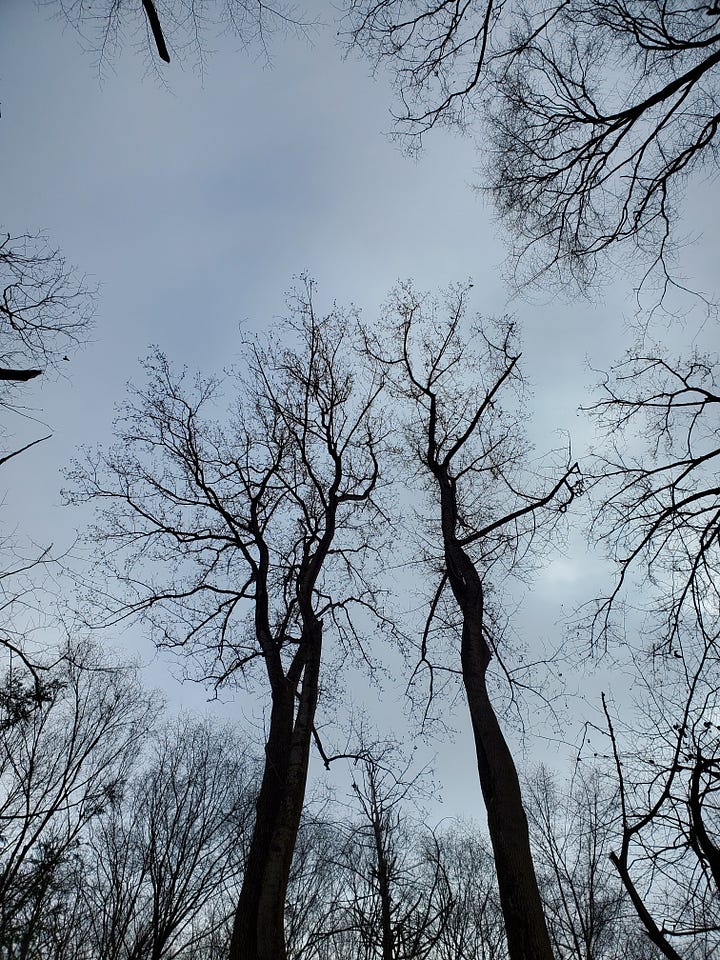
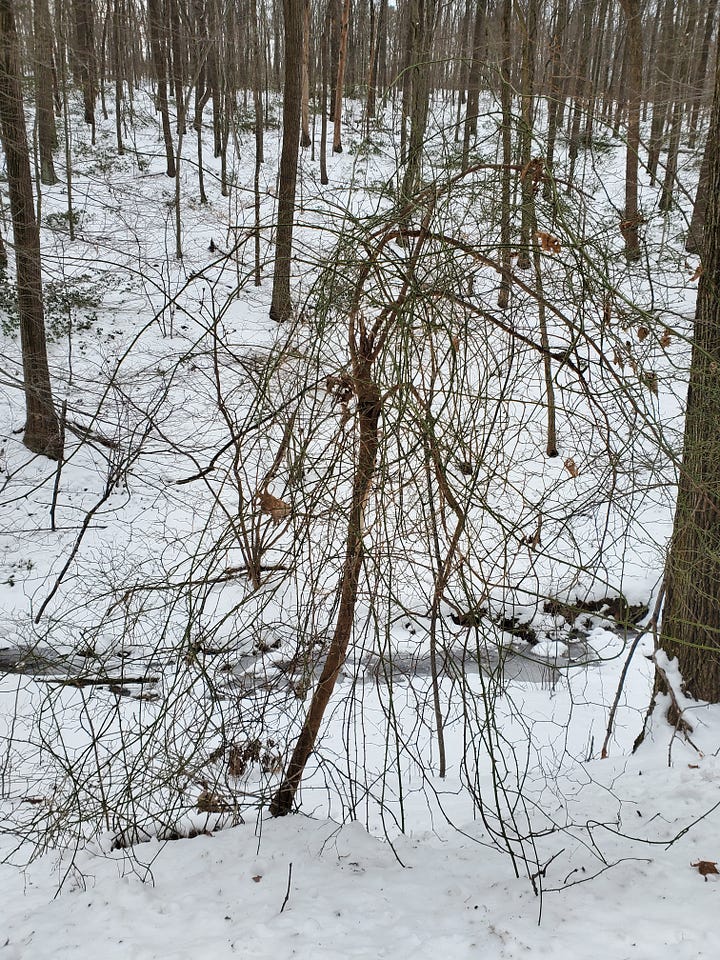
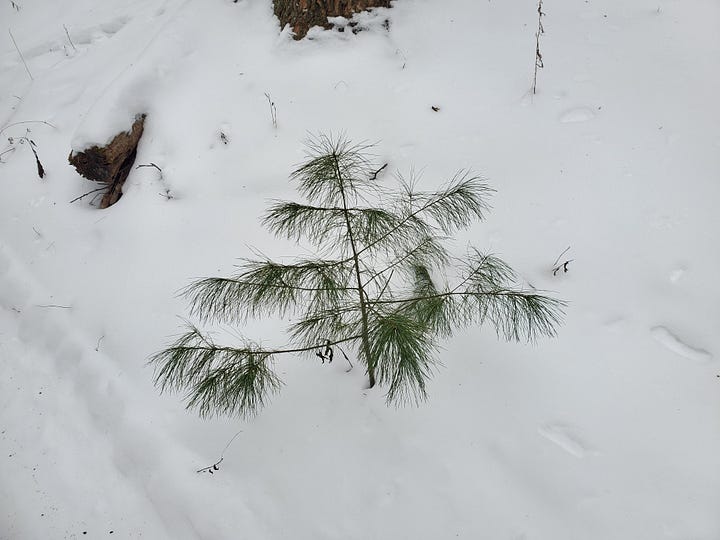

Ducks at Dusk
On Thursday, it begins to warm enough to classify as a January Thaw. When I was a small child, back in the seventies, I was fascinated with these. In those days, it seemed as if every winter saw sub-zero temperatures, with warm days only in the 20s, even though I suppose that was just my childish perspective. On days when the mercury would get closer to freezing, my mom would take me up to a mossy spot on the powerline, and I would marvel at the slight melting taking place. Back in those days, one knew that the cold would soon return, and that Spring wasn’t coming until March 1. These past few years, February has been the new March; we’ll see if that holds in 2025.
During this thaw, I opt for a long afternoon hike to see if anything new has showed up on the mountain, or anything has gone missing. January species numbers are tracking considerably lower than last year with its phoebes, falcons, and other fair-weather species to fluff the total. By now, it seems almost as if every bird not tough enough is either gone or dead. Even Northern Flickers have abandoned the mountain, and the species count hasn’t even reached 50 yet. During the first Plummer’s Hollow 200 in 2023, we finished January with 57 species, and last year reached an all-time high of 63.
One notable absence is the Hermit Thrush from its preferred spot in the tangles to the left of the powerline. At the Far Field, a Red-tailed Hawk flushes and circles but refuses to leave. All is quiet, as befitting 3 PM, but a single playback brings a silent, curious Red-headed Woodpecker in to a nearby black locust, followed by a raucous Red-bellied to the tip of a tall oak. Later, with a quick dusk approaching, I high-tail it down the road, stopping briefly the chat with Dave, who’s getting in some quick sled runs before dinner. The Hollow starts to come alive again just before 5, with Golden-crowned Kinglets and Brown Creepers vocalizing frantically as they return to roost. Winter Wrens appear as if by magic—they were nowhere to be seen on the walk up this afternoon, but at least two, and probably more, flit and hop about now, calling, then scooting under rocks and limbs. The Hairy Woodpecker who lives at the base of Laurel calls as I approach the last turns.
One more check for birds at the bridge; not expecting much, I don’t even get out, just glassing the open water channel well upstream from te comfort of the car seat. A Winter Wren bups down below. And there they are—a splashing crowd of waterfowl! I can make out Mallards and not much else, but a flash of white and black mixed in with them catches my eye. Could be something rare or even new (for our duck-deficient hotspot). There’s still time—I gun it back into town and rush inside to grab scope and digital camera, then back to the bridge. However, it’s now too dusky to make out what’s up there.
Plan B: I walk quickly through terra nullius, hoping not to spook the flock when I pop up above the levee across from them. Now well past 5:30 PM, even the cardinal ticks have ceased. My plan works: the crowd of Mallards has nowhere to go outside the ice-free channel, and isn’t interested in flying. Disappointingly, though, the black-and-white individual is a domestic-type Mallard. Hope springs eternal; I’ll be back tomorrow morning to see if any of the smaller, browner fowl in the 20+-duck flock are anything else.
On Friday morning, I don’t have to go far to find the ducks again. Around 8, as I’m heading out, it occurs to me to check the confluence first. There they all are in the ice-free pool where the waters meet, a few waddling around the ice. Eleven males, eleven females, and that odd, domestic-type individual of indeterminate sex.
Summer in January
With the Tundra Swans that were picked up on Eric’s PUC mike during the afternoon of the 19th, the year list stands at 49. Sunday morning is the first full balcony sit in quite awhile, and with the temperature a balmy 33 with a breeze, perhaps the warmth and overnight melting will bring something new. We’re particularly deficient in raptors—not a vulture or falcon has poked its head over the ridges so far this year (they tend to stay out in the valleys to the east when the weather is frigid). Even Bald Eagles have gone missing.
At 7:01 AM, Mallards, presumably members of the Flock of 23, start flying about, back and forth and around and around, from Bald Eagle Creek to the river, likely searching out new patches of open water that have emerged overnight. Even in the gloom, I can easily make out the black and white pattern of the domestic-type in a group of five.
At 7:04, a fast-moving flock of Rock Pigeons comes out like a cloud of bats, whirling around and spiraling off toward the Gap. One peels off and heads back into town. Then a House Finch to a feeder, and an American Tree Sparrow, destination unknown.
With light still low, a dark shape plunges slightly below the Sapsucker ridge line. A Red-tailed Hawk is up early on the breeze, only the third time I’ve seen one from the balcony all month. Mallards are still flying about, sometimes so low I can hear their wing whistles overhead.
Then ten minutes of nothing as the initial rush subsides.
The dead Sunday air is eventually broken by the insistent yammering of a White-breasted Nuthatch, moving about in the willows. At one point, it alights on the electric pole in the parking lot, presumably searching for last fall’s cache. Then the first goldfinch goes over somewhere, a Carolina Wren down-trills from the confluence, and American Crows take to the skies.
A silent pair of Red-winged Blackbirds (#50), flies north to south across town. I wonder if the breeze brought them up or if they do this every morning. I wouldn’t be surprised if they roost near someone’s feeder; we saw one at a Northwood feeder on Christmas Bird Count over a month ago.
At 7:22, three ravens arrive and take over the heavens. And then a welcome returnee: a loud rattling overhead, and a sharp, diving bird, all bill, plunging into the confluence at top speed. The Belted Kingfisher is making its first appearance in two weeks, having exited our stretch of river during the freeze-up. This particular bird rattles incessantly, first downriver, then upriver.
With the nuthatch continuing its 3- to 9-note nasal calls, the first starling arrives at 7:27, cheering and jumping the gun a bit, singing poorly executed phoebes and meadowlarks. In the background, a Downy Woodpecker, always the late riser, starts to call.
And now, a bit more summer as House Finches and starlings both are singing lustily. Rock Pigeons are up in numbers, swirling about in wild abandon, with starlings and House Sparrows occasionally mixing in. The smaller birds scatter at one point as a Cooper’s Hawk, high up by Sapsucker, stoops and hurtles down on top of them.
And finally, the Bald Eagle deigns to make an appearance—an adult, riding the gale on crooked wings, straight north to south along the ridges, as if in migration.
Later, I walk the tracks and find a sizeable crowd of robins in Redstart Swamp, where I can’t recall ever seeing them before. The reason is soon clear. Some 25 famished birds are gorging on dusky blue privet berries, which I’m guessing are well down their list of preferences.
Some time after four PM, with temperatures still in the 30s, and warmer in the sun, Paola and I glance out the kitchen window and are amazed by the massive bulk of a Great Blue Heron circling over the apartment. Another warm-weather returnee; I haven’t seen any of these since the two along the river on New Year’s Day.
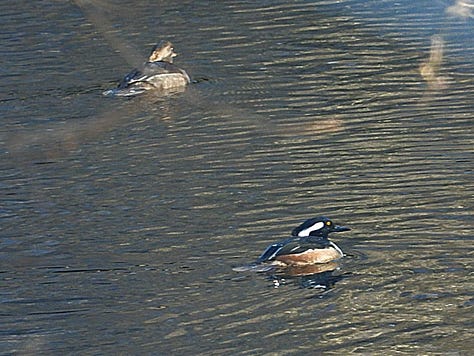
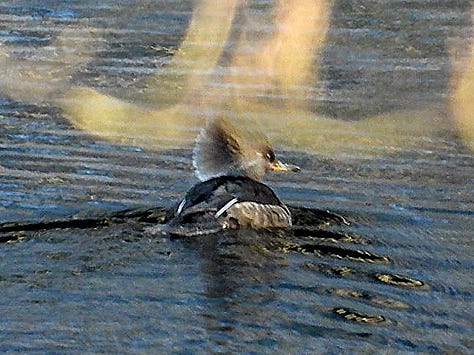
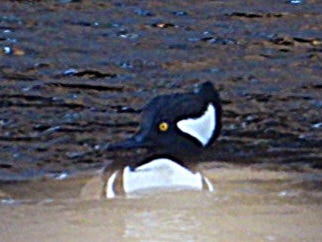
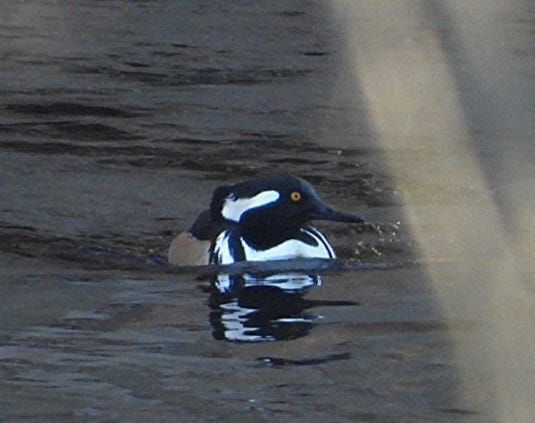
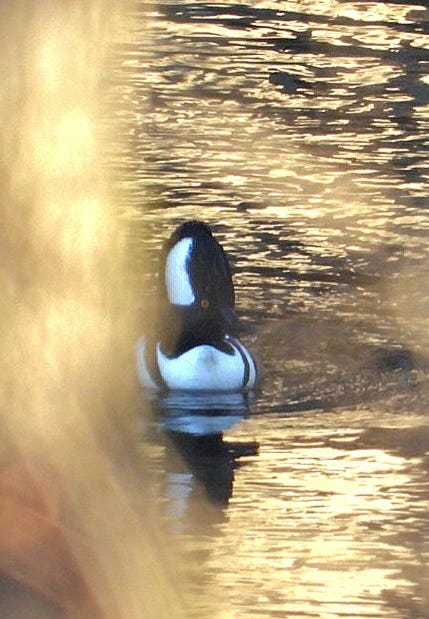
On Monday, a Hooded Merganser pair shows up at the confluence, swimming and diving in the late afternoon sunlight. I’m guessing it’s the same duo I glimpsed downriver a couple weeks ago. Today, from my balcony perch, I get by far the best views of this species I’ve ever had here.
Around 6:30 PM, Dave texts to say that he just flushed a pair of Ruffed Grouse from the woods just above his house. It seems to me that this is the closest we’ve seen them in years.

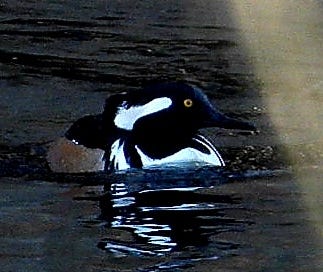



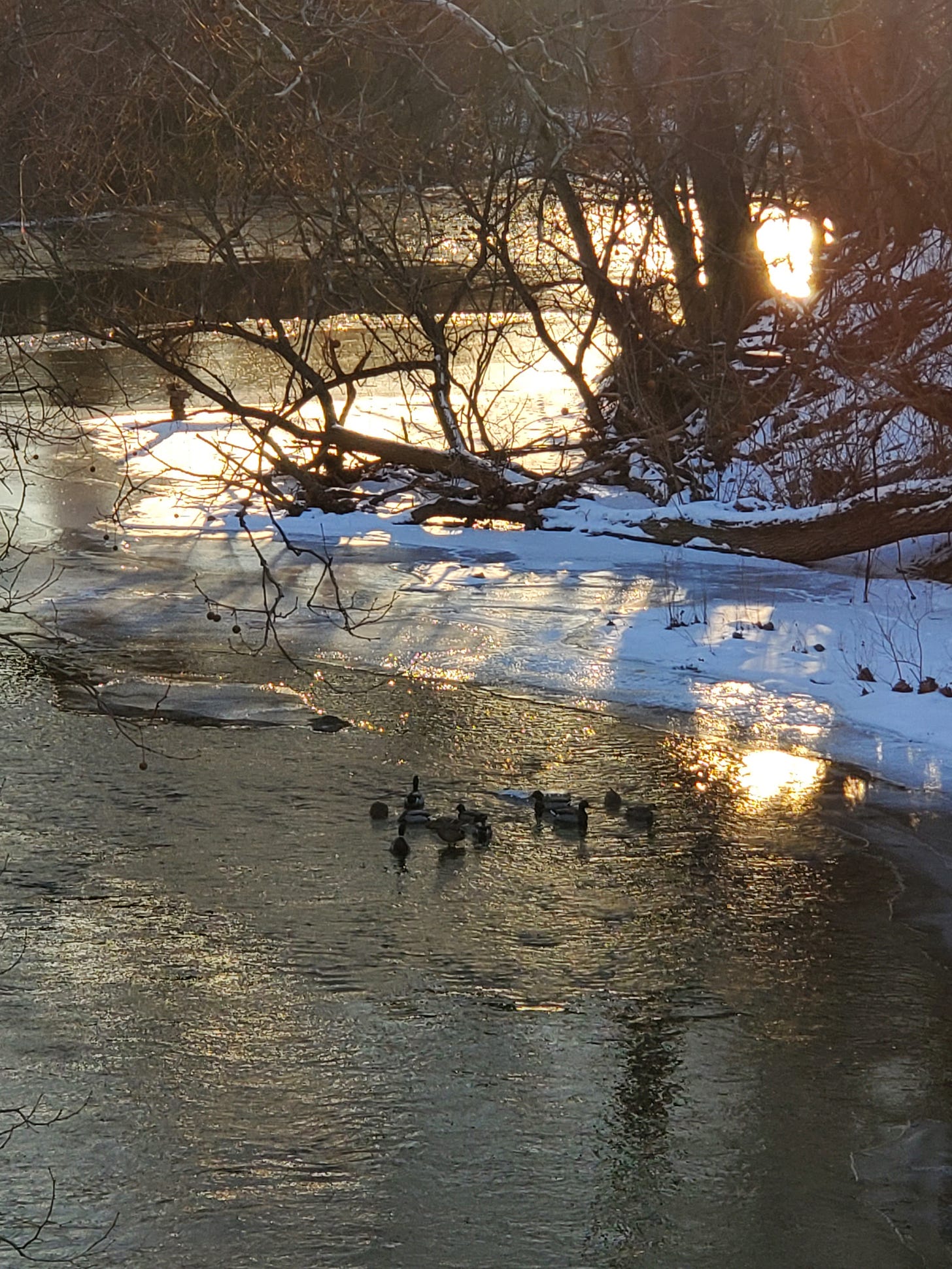
Beautiful photos of the landscape.